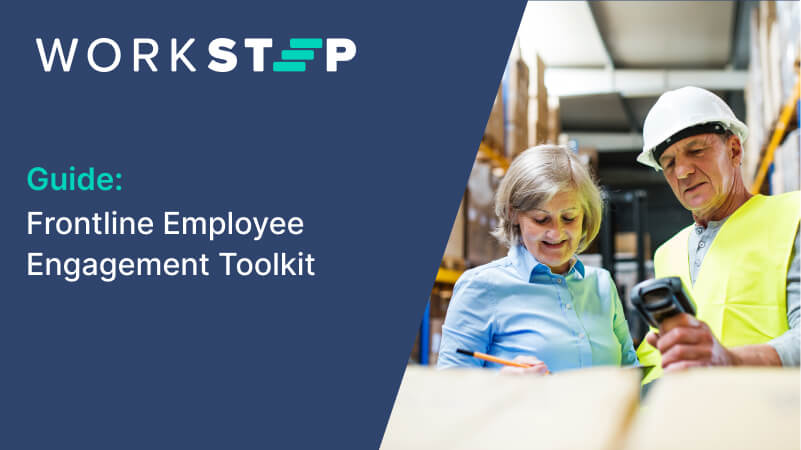How to create an effective employee engagement survey for your frontline workers
April 18, 2023
Frontline employees are the backbone of your company. As such, it’s important to cultivate their satisfaction and loyalty. One way to achieve this is by implementing effective employee surveys to ensure your frontline workforce feels heard and valued.
Robust employee engagement platforms with survey functionalities can help. These tools provide valuable insights into the motivations of your frontline workforce, helping you engage employees, actively address their concerns, and retain employees for the long-haul.
What is the purpose of employee engagement surveys?
The purpose of employee engagement surveys is to gather feedback from employees on their job satisfaction and commitment. The surveys are designed to assess the overall employee experience from leadership to culture to benefits. By analyzing survey results, companies can identify areas of strength and weakness, take action to address issues, and drive overall business success.
What should you measure with your survey?
Employers should seek to measure overall job satisfaction through use of an employee Net Promoter Score (eNPS). To get this output, you need to build effective survey questions that gather insights on employee motivation, career development opportunities, job fit, recognition, work-life balance, workload, leadership effectiveness, and company culture, to name a few.
What do you need from your employee engagement survey platform?
When evaluating employee engagement platforms, it’s important to find a solution that offers surveys specifically with the needs of your frontline workforce in mind. Here are some of the things to keep in mind when choosing a solution.
1. Full anonymity
Building trust with your frontline workers can be challenging to achieve as, historically, frontline workers have felt underserved and undervalued in our society. To get honest and actionable insights, your workers need to feel safe in sharing their feedback with the organization and that means providing full anonymity to them, free of any retribution from leadership.
Therefore, it’s critical that you choose an employee engagement platform that can protect their anonymity and make it very difficult, if not entirely impossible, for leadership to tie feedback to any one individual.
When implemented correctly, anonymity and confidentiality can help employers create a safe and secure environment that fosters open communication and transparency, ultimately leading to improved employee engagement and better business outcomes.
2. User-friendly interface
Your frontline workforce doesn’t spend their day at the computer. And they’re certainly not going to waste time learning how to navigate tricky technology. Your survey platform needs to offer a user-friendly interface.
When a survey is easy to navigate, visually appealing, and has a clear structure, it can help employees feel more comfortable and engaged with the process and significantly impact the quality and quantity of responses received
A well-designed user interface can also reduce the likelihood of employee frustration or confusion, leading to higher response rates and more accurate feedback.
3. Text & email availability
Your corporate workforce may be most comfortable with email, but your frontline employees may not be. These employees often have limited or no access to computers during their workday. Therefore, it’s essential to provide mobile options, such as SMS texting to ensure seamless communication and increased participation in feedback collection.
It is important that your employee survey platform also enables email communications, since text and email will be the most common ways frontline employees can be reached. Providing multiple options for communication increases the likelihood of gathering valuable data from a larger portion of your workforce.
Keep in mind that frontline, hourly workers are always on the move, on their feet, and on the clock. They don’t have the time to stop into the office to sit down at a workstation and complete a survey, and they should not be expected to complete a survey on their own time on a home computer if they have one. A great employee engagement survey will reach them where they are.
4. Real-time feedback collection
The ability to collect real-time employee feedback is especially vital for companies that employ a frontline workforce majority. This is because there are day-to-day issues that arise in the frontline such as safety concerns or customer conflicts that are especially imperative to act on in the moment. Offering always-on and bi-directional feedback channels allows employees to share their thoughts and concerns at any time, helping you spot potential issues and take swift action.
Imagine a world where an employee reports an issue within the first hour of their shift, that issue is then promptly flagged by management, and then resolved before that same employee goes on their lunch break – a tremendous amount of trust is built.
This real-time feedback can provide more accurate insights into employee sentiment and engagement levels as it captures their feelings and opinions in the moment. And timely action on employee feedback can not only help you resolve issues, but also supports an environment where each employee feels valued, respected, and heard.
5. Loop closure
In a similar vein, your employee engagement survey platform should enable employers to respond to urgent comments and alerts (“closing the loop”).
When an employee submits feedback or raises a concern, they want to know that their voice is being heard and that action is being taken. Loop closure ensures that employees receive a response to their feedback, and that management takes appropriate steps to address any issues or concerns.
In short, loop closure helps to build a two-way dialogue between management and employees, which is crucial for creating a positive and productive work environment, where employees feel valued and supported.
6. Segmented messaging
Segmented messaging is important because it allows for tailored communication that is relevant to specific groups of employees. By dividing employees into segments based on factors such as location, department, or job level, organizations can ensure that messages are targeted and personalized to their frontline workforce.
This not only increases the effectiveness of communication, but it also helps employees feel valued and engaged by demonstrating that their individual needs and perspectives are being considered. Additionally, segmented messaging can be used to address specific issues or concerns that are unique to certain populations within the workforce, helping to build trust and improve overall employee satisfaction.
For instance, a company-wide announcement should not be necessary to inform third-shift forklift drivers that a machine in desperate need of repair has finally been serviced. Or, if there is construction on a specific route to a facility, it could go a long way to message employees commuting from that direction and let them know to either give themselves more time on the way in or seek an alternate way to work. Targeted, segmented messaging ensures managers can connect with the specific populations of employees with a message that resonates most with them, adding a personal touch that is much appreciated down the line.
Conclusion
If you employ a frontline workforce, you need an employee engagement survey platform that truly services their needs. By prioritizing high-impact features such real-time feedback collection, advanced segmentation, impact analysis, and loop closure, you can gather valuable insights and implement strategies that result in increased retention, productivity, and reduced costs. Remember, a happy and engaged workforce translates to a thriving business!
Ready to gather real-time employee feedback?
Understand your workforce at scale. Hear from your employees throughout their journey and gain insights into turnover drivers and opportunities for action with WorkStep.
Tom Goyette, Product Marketing Manager | tom.goyette@workstep.com
Tom Goyette is a Product Marketing Manager at WorkStep. With experience in start-up and enterprise level SaaS and eCommerce organizations, Tom excels at managing and creating content, marketing, and analytics. Tom believes people are at the center of every great organization and is eager to share stories that highlights the value of the employee voice.



